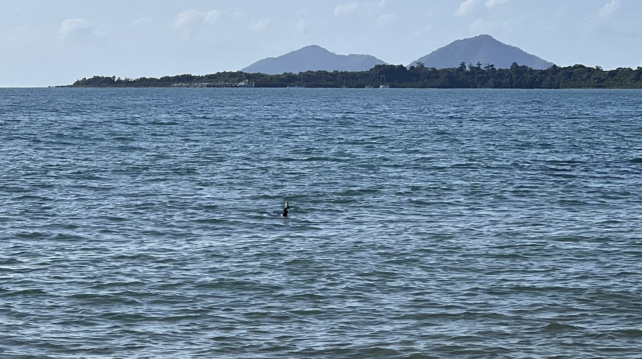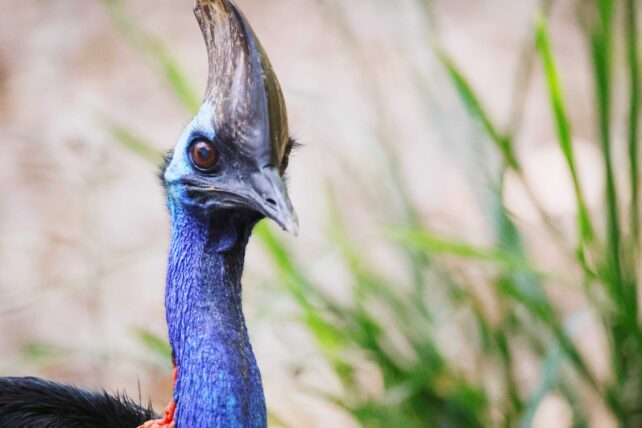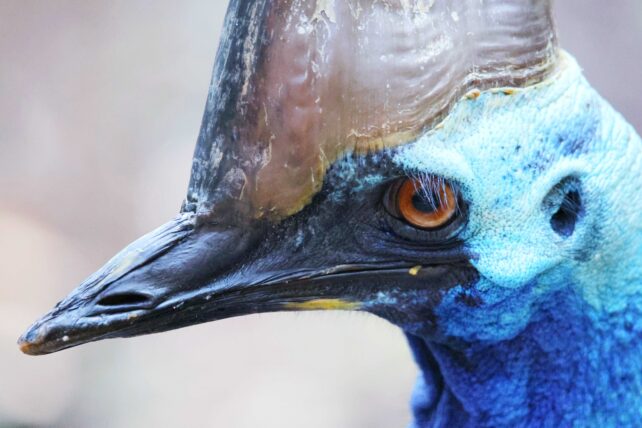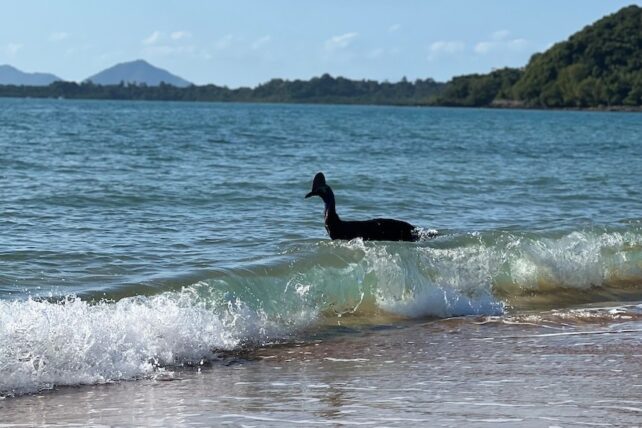Beachgoers at Bingil Bay on the east coast of Australia got a shock on Halloween as an ominous, dark shape splashed about in the water.
Onlookers initially thought it was a shark’s fin or perhaps a turtle. But as the creature emerged it became clear it was something else entirely: a young cassowary, widely known as the world’s most dangerous bird.
The sighting was reported to Queensland’s Department of Environment and Science on October 31 and has since gone somewhat viral.
@brisbanetimes
Australia, home of deadly swimming cassowaries. ???? Video by Nikita McDowell via Environment Department #cassowary #cassowaries #aussieanimals #aussiewildlife #australiananimals
♬ original sound – brisbanetimes
Cassowaries are famous for their prehistoric appearance, height, and strong legs and clawed feet, with the potential to do some serious damage. The flightless birds are sensibly quite wary of humans and unlikely to attack unless provoked.
The sighting of a southern cassowary (Casuarius casuarius johnsonii) in the water comes as a surprise as many people don’t realize cassowaries can swim.
(Nikita McDowell)
“Cassowaries can swim and will take to the water to cross from one side of a river to the other, or if they feel threatened by domestic dogs or another cassowary through a territorial dispute,” wildlife officer Stephen Clough from the Queensland Parks and Wildlife Service (QPWS) explained in a press release.
“We’re not sure how long this animal was in the water or why it went for a swim but the footage is astonishing.”
 (Nikita McDowell)
(Nikita McDowell)
According to reports from Bingil Bay Campground host Nikita McDowell, the bird was swimming about 200 meters (656 feet) offshore.
“I ran down and waited for the cassowary to emerge from the ocean, and it must’ve been exhausted as it stood in the shade beneath a tree with its legs shaking for about half an hour,” said McDowell.
“Perhaps it entered the ocean around south Mission Beach and was caught by the current or in a rip and swept around to Bingil Bay,” she added.
 Australia’s southern cassowary (Casuarius casuarius johnsonii) (Tessa Koumoundouros)
Australia’s southern cassowary (Casuarius casuarius johnsonii) (Tessa Koumoundouros)
Bingil Bay is north of Mission Beach in tropical north Queensland, and the region is often referred to as the ‘Cassowary Coast’. The traditional owners of the land call the area Djiru Country and refer to the cassowary as the goondoi.
The bird is a significant species to first nations people in Australia and plays a key role in propagating rainforest trees – some of which won’t germinate until they’ve passed through the large herbivore’s digestive system.
 Australia’s southern cassowary (Casuarius casuarius johnsonii) (Tessa Koumoundouros)
Australia’s southern cassowary (Casuarius casuarius johnsonii) (Tessa Koumoundouros)
Sadly, there are now only an estimated 4,000 cassowaries remaining in Queensland, and the population is listed as endangered under the Nature Conservation Act 1992.
The birds are threatened by vehicle strikes and dog attacks, and visitors to the area – which is just north of Mission Beach in tropical north Queensland – are advised to never approach the birds and give them plenty of space.
“This rare sighting and lucky escape by the cassowary is a reminder that we all need to do what we can to protect and conserve the species,” said Clough.
 (Nikita McDowell)
(Nikita McDowell)
So are cassowaries really that dangerous? Alongside ostriches, they’re one of only two bird species that have been known to have caused human death by physical attack.
A review on cassowary attacks published in 2006 in the Journal of Zoology looked at 221 observed cassowary attacks, of which 150 were against humans.
A staggering 75 percent of those attacks were a result of humans feeding the birds (which they are advised not to). A little over 70 percent of the time, the birds charged, and they only used their claws in 15 percent of attacks.
So if you’re lucky enough to come face-to-face with one of these beauties, remember not to approach it or attempt to feed it. Especially if there are eggs or chicks nearby!
Back away slowly and attempt to put a backpack or other item between you and the bird, the Department of Environment and Science advises.
And when planning your escape, remember: they can swim!

